Lynx Spiders: Oxyopidae Checklist
Lynx spiders of the family Oxyopidae got their name from their hunting behaviour, akin to that of the Lynx cats. They are adept at chasing after their prey from leaf to leaf and some are capable of leaping to catch their prey in flight.
The taxonomy of the genera in Oxyopidae is unfortunately not very well-defined. While some key traits are listed for some genera on this page, it won’t be surprising to find some species that obviously do not match the genus diagnosis. Those are likely to be due for a taxonomic revision in the future.
Checklist
This page consists of a personal checklist of all lynx spiders that I’ve encountered over the years.
This page will be updated regularly, please let me know if you spot any mistakes.
View my Oxyopidae Flickr photo album
References:
- Deeleman-Reinhold, 2009a Description of the lynx spiders of a canopy fogging project in northern Borneo (Araneae: Oxyopidae), with description of a new genus and six new species of Hamataliwa
- Brady, 1964 The lynx spiders of North America, north of Mexico (Araneae: Oxyopidae)
- Mello-Leitão, C. F. de (1929a) Oxyopideos do Brasil. Revista do Museu Paulista
- World Spider Catalog: Oxyopidae
- Koh, Court, Ang & Ng 2022 A Photographic Guide to Singapore Spiders

Oxyopidae eye arrangement with small AME, and ALE, PME, PLE in a hexagonal layout
Region Filters
Click on any region to show only records from that region.
Phylum: Arthropoda von Siebold, 1848
Subphylum: Chelicerata Heymons, 1901
Class: Arachnida Lamarck, 1801
Order: Araneae Clerck, 1757
Infraorder: Araneomorphae
Superfamily: Lycosoidea
Family: Oxyopidae Thorell, 1869
Genus: Hamadruas Deeleman-Reinhold, 2009
Hamadruas diagnosis [1]
- Carapace lower, head having straight sides sinuating to the thorax, instead of convex in Hamataliwa and Tapponia
- Head width 25% less than carapace
- Carapace dorsally with shallow saddle, higher in front than behind
- Rear face of carapace sloping
- Abdomen 50-100% longer than carapace, narrow distally, parallel-sided
- Abdominal dorsum usually with geometric colour pattern
- Length of legs from longest to shortest: I, II, III, IV
- Legs much longer than that of Hamataliwa
Genus: Hamataliwa Keyserling, 1887
Hamataliwa diagnosis [1]
- AME less than its diameter apart
- PME 1-4 times their diameter apart
- Length of legs from longest to shortest: I, II, III, IV
- Posterior legs about 30% shorter than anterior legs
- Patellae, tibiae, metatarsi of all legs bear numerous long, thin and erect dorsal and lateral spines
- Carapace very high, almost square
In Hamataliwa, the height of carapace and width of eye group is very variable and not a reliable trait for identification.
Genus: Oxyopes Latreille, 1804
Oxyopes diagnosis [1]
- AME smallest, distance apart more than AME diameter.
- PME and PLE subequal in size and larger than AME but slightly smaller than ALE
- ALE largest
- AME row smallest
- ALE row subequal to PME row
- PLE row widest
- Usually a pair of black lines that runs from the AME through the clypeus and extends to the chelicerae
Many species of Oxyopes, especially O. lineatipes, O. birmanicus and O. javanus are difficult to differentiate from external morphology and pattern alone.
Genus: Peucetia Thorell, 1869
Peucetia diagnosis [1]
- Toothless chelicerae
Genus: Tapinillus Simon, 1898
Genus: Tapponia Simon, 1885
Tapponia diagnosis [1]
- PER almost straight
- Line connecting anterior margin of PME with posterior margin of PLE recurved
- Clypeus equal to distance between ALE
- Abdomen densely covered with iridescent setae
- Legs IV longer than legs III





































































































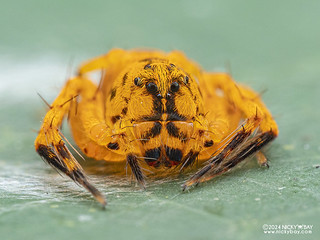




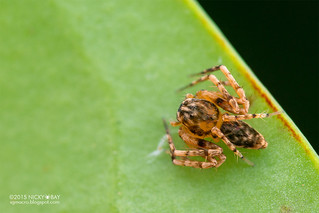






















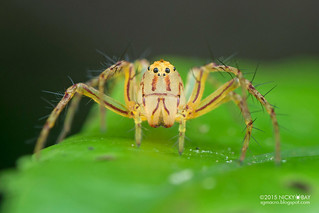





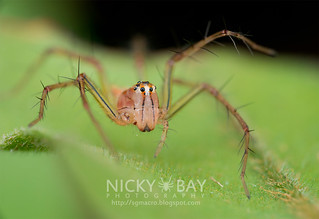







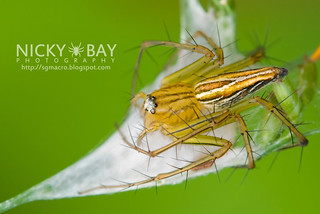



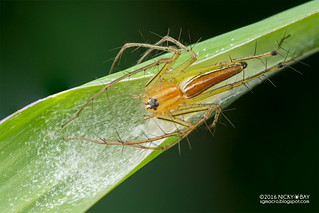























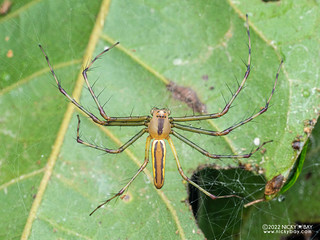





















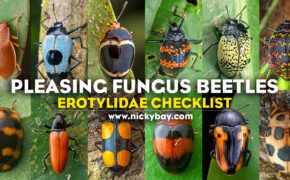

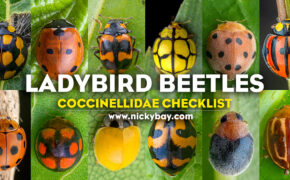










Abida Butt
good work